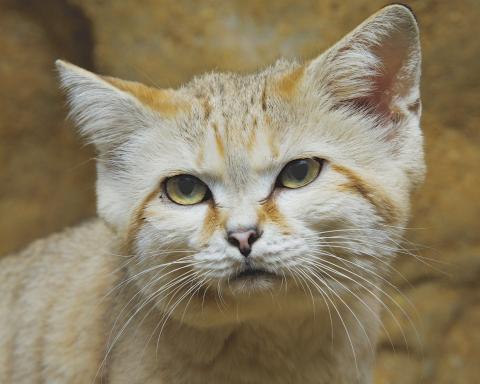News Archive
Filter By
- Abyssinian ground hornbill
- Addax
- Aldabra tortoise
- Allen's swamp monkey
- Alpaca
- American alligator
- American avocet
- American bison
- American flamingo
- American wigeon
- Andean bear
- Aquatic caecilian
- Arapaima
- Asian elephant
- Asian small-clawed otter
- Asian water dragon
- Australian snake-necked turtle
- Bald eagle
- Baltimore oriole
- Barred owl
- Bearded emperor tamarin
- Beaver
- Bennett's wallaby
- Binturong
- Black-and-white ruffed lemur
- Black-crowned night heron
- Black-footed ferret
- Black-tailed prairie dog
- Black-throated blue warbler
- Blue-billed curassow
- Blue crane
- Bobcat
- Brown pelican
- Bufflehead
- California sea lion
- Canvasback
- Cedar waxwing
- Channel catfish
- Cheetah
- Chicken
- Chinese alligator
- Chinese three-striped box turtle
- Clouded leopard
- Collared brown lemur
- Common raven
- Common yellowthroat
- Corals and sea anemones (anthozoa)
- Cow
- Crocodile monitor
- Cuban crocodile
- Dama gazelle
- Degu
- Dunlin
- Eastern corn snake
- Eastern indigo snake
- Eastern newt
- Eastern red-backed salamander
- Eastern screech-owl
- Eld's deer
- Electric eel
- Emperor newt
- Fennec fox
- Fishing cat
- Gaboon viper
- Geoffroy's marmoset
- Gharial
- Giant leaf-tailed gecko
- Giant panda
- Goat
- Golden-headed lion tamarin
- Golden lion tamarin
- Gray seal
- Gray wolf
- Green tree python
- Grevy's zebra
- Guam kingfisher (sihek)
- Guam rail (ko’ko’)
- Guinea pig
- Harbor seal
- Hartmann's mountain zebra
- Hawk-headed parrot
- Hellbender
- Home's hinge-back tortoise
- Hooded crane
- Iranian fat-tailed gecko
- Japanese giant salamander
- King vulture
- Komodo dragon
- Kori bustard
- Kunekune pig
- Land hermit crab
- Larger Malay mouse-deer
- Lemur leaf frog
- Lesser hedgehog tenrec
- Lesser kudu
- Lion
- Loggerhead shrike
- Long-tailed chinchilla
- Long-tailed salamander
- Maned wolf
- Meerkat
- Miniature donkey
- Naked mole-rat
- North American porcupine
- North American river otter
- Northern Luzon giant cloud rat
- Northern pine snake
- Northern pintail
- Northern red salamander
- Northern snakehead fish
- Northern tree shrew
- North Island brown kiwi
- Norway rat
- Orangutan
- Orchard oriole
- Ossabaw Island hog
- Ostrich
- Ovenbird
- Pallas's cat
- Panamanian golden frog
- Patagonian mara
- Persian onager
- Philippine crocodile
- Prehensile-tailed porcupine
- Prevost's squirrel
- Przewalski's horse
- Pygmy slow loris
- Red-crowned crane
- Red-fronted lemur
- Red-rumped agouti
- Red-winged blackbird
- Red knot
- Red panda
- Red River hog
- Red ruffed lemur
- Red wolf
- Ring-tailed lemur
- Ruddy duck
- Schmidt's red-tailed monkey
- Scimitar-horned oryx
- Screaming hairy armadillo
- Semipalmated plover
- Semipalmated sandpiper
- Siamang
- Sitatunga
- Sloth bear
- Southern lesser galago
- Southern swamp sparrow
- Southern tamandua
- Spider tortoise
- Striped skunk
- Tanagers
- Tentacled snake
- Tiger
- Titi monkey
- Turkey
- Twig catfish
- Two-toed sloth
- Vietnamese mossy frog
- Virginia opossum
- Von der Decken's hornbill
- Western lowland gorilla
- White-cheeked gibbon
- White-faced saki
- White-naped crane
- White-nosed coati
- Whooping crane
Displaying 1476 - 1500 of 2363 articles.
Bei Bei is Getting Feisty
On October 8, vets performed an exam on Bei Bei. He weighed in at 5.9 pounds. His eyes are now fully open and he is getting more active and rambunctious. He also received his first vaccination. Before the full veterinary exam, our chief veterinarian Don Neiffer settled the panda cub by massaging two...
A Living Classroom
What better way is there for students to learn about the environment than being immersed in it? That’s how students at the Smithsonian-Mason School of Conservation (SMSC) are learning about animals and their ecosystems. The school welcomes students and professionals from all over the world to live...

SCBI's Loggerhead Shrikes Released in Canada
Seven loggerhead shrikes that hatched in May have become the first of their species born at SCBI to be released into the wild! Now in Canada, they're helping to bolster native populations. But why are these “butcher birds” in decline? Hear from animal keeper Chris Crowe how SCBI is trying to crack...
New Study From Smithsonian Conservation Biology Institute Reveals Secrets of African Lion Reproduction
For the first time ever, zoos will have access to the most comprehensive information about female African lion reproduction as the result of an eight-year study from the Smithsonian Conservation Biology Institute (SCBI) and partners. The findings were published Tuesday, Oct. 13, in the scientific...
Giant Panda Update Oct 9, 2015 Panda Cam Favs
Look at those toes! Our favorite panda cam shot from our #PandaStory Flickr album this week was from user partipersian. Look at those toes! Our favorite panda cam shot from our #PandaStory Flickr album this week was from user partipersian. A photo posted by Smithsonian's National Zoo (...
Giant Panda Update Oct 9, 2015 Veterinary Exam
Yesterday, before Bei Bei's full veterinary exam our chief veterinarian Dr. Don Neiffer settled the little panda cub by massaging two pressure points at the base of his skull. And Bei Bei really seemed to enjoy it. He closed his eyes, rested his chin on Dr. Neiffer's hand and relaxed. #PandaStory ...
Eld's Deer Born at the Smithsonian Conservation Biology Institute
The Smithsonian Conservation Biology Institute in Front Royal, Va. is celebrating the birth of two male Eld's deer, an endangered species native to Myannmar. The first fawn, pictured here, was born Sept. 26 to 7-year-old mother Sherri and 6-year-old father Nam Tann. On Sept. 27, a second fawn was...
Bei Bei's Eyes are Opening
Keepers had a chance to weigh Bei Bei on Thursday, October 1, when Mei Xiang left her den to eat. He now weighs about 5 lbs. This is an increase of a pound since he was weighed last week! Vets also did a thorough checkup and took some body measurements. Bei Bei's head to the tip of his tail measures...
Giant Panda Update Oct 5, 2015
The classic nose to nose nuzzle! Thanks to Janet Crouse for sharing. Post fav cam screenshots of#BeiBeiand Mei Xiang to our#PandaStoryFlickr group. We'll share a great one each week! Keepers had a chance to weigh Bei Bei on Oct. 1. He now weighs 4.5 lbs. (2070g)?half a pound increase since he was...
Giant Panda Update Oct 1, 2015
Q: What do we call a giant panda cub sneeze? A: Bei Bei choo! #PandaStory #BeiBei @michelleobama @smithsonian Q: What do we call a giant panda cub sneeze? A: Bei Bei choo! #PandaStory #BeiBei @michelleobama @smithsonian A video posted by Smithsonian's National Zoo (@smithsonianzoo) on Sep 29, 2015...
Cheetah Sperm Quality
Why is it difficult to breed cheetahs in human care? Smithsonian Conservation Biology Institute (SCBI) scientists addressed that question in a PLOS-ONE paper paper entitled, "Motile Sperm Output by Male Cheetahs (Acinonyx jubatus) Managed Ex Situ Is Influenced by Public Exposure and Number of Care...
Oryx Calf Update: Bottle Feeding Q&A
In summer 2015, the Smithsonian Conservation Biology Institute celebrated the birth of seven scimitar-horned oryx calves. When keepers noticed that a female calf named Esmerelda wasn't getting the maternal care she needed, they leapt into action. Keeper Dolores Reed bottle-fed Esmerelda, and now she...
Oct. 3 and 4: Smithsonian Conservation Biology Institute To Host Annual Autumn Conservation Festival - CANCELLED
This weekend, Oct. 3 and 4, the Smithsonian Conservation Biology Institute (SCBI) in Front Royal, Va., will open to the public for its annual Autumn Conservation Festival. Held from 10 a.m. to 3 p.m., the Festival will allow visitors to explore the scenic facility, view endangered species—such as...
Smithsonian's National Zoo Receives National Award for Excellence in Marketing
The Association of Zoos and Aquariums (AZA) announced that the Smithsonian's National Zoo and Conservation Biology Institute received Top Honors in marketing for budgets under $175,000 for their Endangered Song Project.
Smithsonian Conservation Biology Institute Study Finds Forest Giants Suffer Worst During Droughts
In a study published Sept. 28 in the journal Nature Plants, a team led by Smithsonian Conservation Biology Institute (SCBI) scientists found that bigger trees suffer the most during droughts, regardless of location or forest type. The team, including ecologists Kristina Anderson-Teixeira and Amy...
Eld's Deer Dies at Smithsonian Conservation Biology Institute
On September 17, an 4-year-old female Eld's deer was spooked during a semiannual fire safety check on the sprinkler system at the Smithsonian Conservation Biology Institute in Front Royal, Va. The safety test produced a startling noise to which the deer reacted by running into the enclosure's...
First Ladies of US and People's Republic of China Name the Giant Panda Cub at the Smithsonian's National Zoo
This morning, Sept. 25, the giant panda cub born at the Smithsonian's National Zoo Aug. 22 received his name, Bei Bei (BAY-BAY), which means precious, treasure" and is complementary to his sister's name, Bao Bao. In celebration of the state visit and as a special honor for the cub, the name was...
His Name is Bei Bei!
This morning, our giant panda cub received his name: Bei Bei or 贝贝 (BAY-BAY)! Bei Bei means "precious, treasure" in Mandarin Chinese and is complementary to his sister's name, Bao Bao. In celebration of the state visit and as a special honor for the cub, the name was selected by First Lady of the...
Our Panda Cub is Giant!
When Mei Xiang left her den to eat on Sept. 21, keepers took the opportunity to get the latest weight on our not-so-little-anymore giant panda cub. At 4.5 weeks old, the cub weighs 2.95 pounds (1,139 grams). He has now surpassed both of his older siblings in size when they were the same age: Bao Bao...
Weekly Giant Panda Cub Update from the Smithsonian's National Zoo
Keepers had an opportunity to weigh the 4.5 week-old giant panda cub yesterday, Sept. 21, when Mei Xiang left her den to eat. He weighs 2.95 pounds (1,339 grams) and has now surpassed both of his older siblings in size when they were the same age. At 4-and-a-half weeks old, Bao Bao weighed...

Small Mammal Q&A: Learn About Sand Cats
Biologist Kenton Kerns and keeper Maria Montgomery share the scoop on the Zoo's sand cats in the latest Q & A.
Giant Panda Update Sep 18, 2015
Our panda cub scrapbook is growing as quickly as he is—and that's saying something. This is one of our favorite adorable moments from the panda cams this week. This snapshot was added to the #PandaStory Flickr group by user gkoo19681. Our panda cub scrapbook is growing as quickly as he is?and that's...
Smithsonian's National Zoo and Conservation Biology Institute Receives $4.5 Million to Continue Giant Panda Program
David M. Rubenstein has pledged a second $4.5 million gift to the Smithsonian's National Zoo and Conservation Biology Institute, funding its giant panda research and conservation program through the end of 2020. The gift will support conservation efforts in China, research on giant panda...
Giant Panda Update Sep 17, 2015
David M. Rubenstein has pledged a second $4.5 million gift to support our giant panda conservation and research program through the end of 2020. As a result, our scientists will be able to continue all the research they do related to giant pandas and the other species that share their habitat....
